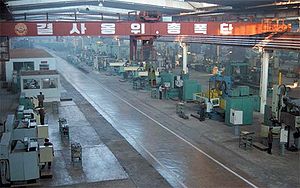Economy of North Korea

|
|
| Currency | North Korean won |
|---|---|
| Calendar year | |
| Statistics | |
| GDP | ~ 40 billion |
| GDP rank | 125th (nominal) / 96th (PPP) |
|
GDP growth
|
1.0% (2014 est.) |
|
GDP per capita
|
$1,800 (2011 est.) |
|
GDP by sector
|
mining and industry 34.4%, services 31.3%, agriculture and fisheries 21.8%, construction 8.2%, utilities 4.3%. (2014 est.) |
|
Main industries
|
Military products, mining (coal, iron ore, limestone, magnesite, graphite, copper, zinc, lead, and precious metals), metallurgy, textiles, food processing. |
| External | |
| Exports | $3.954 billion (2012) |
|
Export goods
|
Minerals, metallurgical products, manufactures (including armaments), textiles, agricultural and fishery products, coal, iron ore, limestone, graphite, copper, zinc, and lead. |
|
Main export partners
|
|
| Imports | $4.83 billion (2012 est.) |
|
Import goods
|
Petroleum, coking coal, machinery and equipment, textiles, and grain |
|
Main import partners
|
|
|
Gross external debt
|
$20 billion (2011 est) |
| Public finances | |
| Revenues | $2.88 billion |
| Expenses | $2.98 billion |
North Korea's economy is a centrally planned system, i.e. the role of market allocation schemes is limited. Although there have been some small-scale reforms as of 2015[update], Pyongyang's basic adherence to a rigid centrally planned economy continues, as does its reliance on fundamentally non-pecuniary (not readily quantified or valued in money) incentives. There have been reports of economic reform, particularly after Kim Jong-un assumed the leadership in 2012, but recent reports conflict over particular legislation and enactment.
The collapse of the Eastern Bloc from 1989 to 1991, particularly North Korea's principal source of support, the Soviet Union, forced the North Korean economy to realign its foreign economic relations, including increased economic exchanges with South Korea. China is North Korea's largest trading partner.
North Korea had a similar GDP per capita to its neighbor South Korea from the aftermath of the Korean War until the mid-1970s, but had a GDP per capita of less than $2,000 in the late 1990s and early 21st century.
Estimating gross national product in North Korea is a difficult task because of a dearth of economic data and the problem of choosing an appropriate rate of exchange for the North Korean won, the nonconvertible North Korean currency. The South Korean government's estimate placed North Korea's GNP in 1991 at US$22.9 billion, or US$1,038 per capita. In contrast, South Korea posted US$237.9 billion of GNP and a per capita income of US$5,569 in 1991. North Korea's GNP in 1991 showed a 5.2% decline from 1989, and preliminary indications were that the decline would continue. South Korea's GNP, by contrast, expanded by 9.3% and 8.4%, respectively, in 1990 and 1991.
It is estimated that North Korea's GNP nearly halved between 1990 and 1999. North Korean annual budget reports suggest state income roughly tripled between 2000 and 2014. By about 2010 external trade had returned to 1990 levels.
...
Wikipedia




